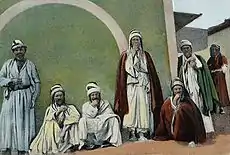Yazidis
Yazidis (also written as Yezidis (/jəˈziːdiːz/ (![]() listen),[27] Kurdish: ئێزیدی/Êzîdî[28][29]) are an endogamous and mostly Kurmanji-speaking[25] minority, indigenous to Upper Mesopotamia.[22] The majority of Yazidis remaining in the Middle East today live in the disputed territories of Northern Iraq, primarily in the Nineveh and Dohuk governorates.[30][31] There is a disagreement on whether Yazidis are a religious sub-group of Kurds or a distinct ethnoreligious group, among scholars and Kurds and Yazidis themselves.[32][33] The Yazidi religion is monotheistic and can be traced back to ancient Mesopotamian religions.[34][35][36]
listen),[27] Kurdish: ئێزیدی/Êzîdî[28][29]) are an endogamous and mostly Kurmanji-speaking[25] minority, indigenous to Upper Mesopotamia.[22] The majority of Yazidis remaining in the Middle East today live in the disputed territories of Northern Iraq, primarily in the Nineveh and Dohuk governorates.[30][31] There is a disagreement on whether Yazidis are a religious sub-group of Kurds or a distinct ethnoreligious group, among scholars and Kurds and Yazidis themselves.[32][33] The Yazidi religion is monotheistic and can be traced back to ancient Mesopotamian religions.[34][35][36]
 Yazidis on the mountain of Sinjar, Iraqi–Syrian border, 1920s | |
| Total population | |
|---|---|
| 1,000,000–1,500,000 (estimate)[1][2] | |
| Regions with significant populations | |
| See List of Yazidi settlements | |
| Listed by countries | |
| 500,000 (2018 estimate)[3] | |
| 200,000 (2019 estimate)[4][5] | |
| 40,586 (2010 census)[6] | |
| 35,000 (2018 estimate)[7] | |
| 35,272 (2011 census)[8] | |
| 12,174 (2014 census)[9] | |
| 10,000 (2017 estimate)[10] | |
| 10,000 (2018 estimate)[11][12] | |
| 10,000 (2017 estimate)[13][14] | |
| 6,000 (2018 estimate)[15] | |
| 5,000 (2010 estimate)[16][17] | |
| 2,738 (2019 estimate)[18] | |
| 1,200 (2018 estimate)[19] | |
| Religions | |
| Yazidism (majority)[20] Armenian Apostolic Church and Evangelicalism (adopted by some in Armenia and Georgia)[21] and Islam (forced conversion)[22][23] | |
| Languages | |
| Kurmanji (Northern Kurdish),[24] Arabic (in Bashiqa and Bahzani)[25] and Armenian (adopted by some in Armenia)[26] | |
In August 2014, the Yazidis became victims of a genocide by the Islamic State of Iraq and the Levant in its campaign to eradicate non-Islamic influences.[37]
Origins
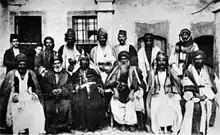
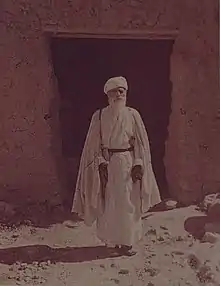
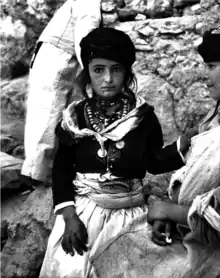

The Yazidis' own name for themselves is Êzîdî or, in some areas, Dasinî, although the latter, strictly speaking, is a tribal name. The origins of the Yazidis are in the dark.[38] Some western scholars derive the name from the Umayyad Caliph Yazīd ibn Muʿāwiya (Yazid I).[39] However, all Yazidis reject any relationship between their name and the caliph.[40] The word "Yazidi" means "the servant of the creator".[41] Other scholars derive it from Old Iranian yazata, Middle Persian yazad, divine being.[42] Another derivation of the word origin relates to Ez dā ("Created me"). Yazidis also refer to Xwedê ez dam ("God created me") and to Em miletê ezdaîn ("We are the Ezdayi nation").[43]
Similarities between the Yazidis and the Yaresan are well established;[44] some can be traced back to elements of an ancient faith that was probably dominant among Western Iranians[45] and likened to practices of pre-Zoroastrian Mithraic religion.[46]
Early writers attempted to describe Yazidi origins, broadly speaking, in terms of Islam, or Persian, or sometimes even "pagan" religions; however, research published since the 1990s has shown such an approach to be simplistic.[25]
Another theory of Yazidi origins is given by the Persian scholar Al-Shahrastani. According to Al-Shahrastani, the Yazidis are the followers of Yezîd bn Unaisa, who kept friendship with the first Muhakkamah before the Azariḳa. The first Muhakkamah is an appellative applied to the Muslim schismatics called Al-Ḫawarij. Accordingly, it might be inferred that the Yazidis were originally a Ḫarijite sub-sect. Yezid bn Unaisa moreover, is said to have been in sympathy with the Ibadis, a sect founded by 'Abd-Allah Ibn Ibaḍ.[47]
According to Ernest Leroux, it is not unlikely that the Yazidis are a remnant of the Babylonians whose cults can also be found among the Yazidis.[38]
Identity
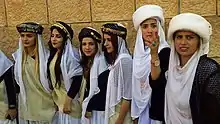
Yazidi cultural practices are observed in Kurmanji, which is also used by almost all the orally transmitted religious traditions of the Yazidis. However, the Yazidis in Bashiqa and Bahzani speak Arabic as their mother language.[25] Although the Yazidis speak mostly in Kurmanji, their exact origin is a matter of dispute among scholars, even among the community itself as well as among Kurds, whether they are ethnically Kurds or form a distinct ethnic group.[33] Yazidis only intermarry with other Yazidis; those who marry non-Yazidis are expelled from their family and are not allowed to call themselves Yazidis.[48][49]

Some modern Yazidis identify as a subset of the Kurdish people while others identify as a separate ethno-religious group.[25][20][51] In Armenia and Iraq, the Yazidis are recognized as a distinct ethnic group.[52][53][54][55] According to Armenian anthropologist Levon Abrahamian, Yazidis generally believe that Muslim Kurds betrayed Yazidism by converting to Islam, while Yazidis remained faithful to the religion of their ancestors.[56] Evliya Çelebi described soldiers of Abdal Khan of Bitlis as "Yezidi Kurds" and in fourteenth century, seven of the most prominent Kurdish tribes were Yazidi, and Yazidism was the religion of the Jazira Kurdish principality. Some traditional myths of the Yazidis tell that the Yazidis were the children of Adam alone and not of Eve, and thus separate from the rest of humanity.[57] In the autonomous Kurdistan Region of Iraq, Yazidis are considered ethnic Kurds[32] and the autonomous region considers Yazidis to be the "original Kurds".[58] The sole Yazidi parliamentarian in the Iraqi Parliament Vian Dakhil also stated her opposition to any move separating Yazidis from Kurds.[32] Aziz Tamoyan the president of the Yezidi National Union ULE and many other Yazidis indicate that the term Yazidi is used for a nation and their language is called Ezdiki and their religion is Sharfadin.[52][59] According to the researcher Victoria Arakelova, Yazidism is a unique phenomenon, one of the most remarkable illustrations of ethno-religious identity, centred on a religion the Yazidis call Sharfadin. And therefore, it is quite legitimate to speak of the unity of both the Yazidi religious identity and Yazidi ethnicity.[60][20]
Yazidis distinguish the name of their community from the name of their religion according the phrase:[61][62][63]
Miletê min Êzîd ("My nation - the Yazidis.")
Dîne min Şerfedîn ("My religion - Sharfadin.")[61][62][63]
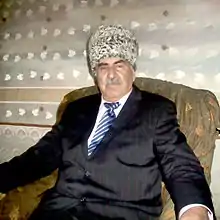
The Soviet Union registered the Yazidis and the Kurds as two different ethnic groups for the 1926 census, but bulked the two together as one ethnicity in the censuses from 1931 to 1989.[64] Sharaf Khan Bidlisi's Sheref-nameh of 1597, which cites seven of the Kurdish tribes as being at least partly Yazidi, and Kurdish tribal confederations as containing substantial Yazidi sections.[65]
Conversely, during his research trips in 1895, anthropologist Ernest Chantre visited the Yazidis in today's Turkey and reported that Yazidis called their language zyman e ezda (the language of the Yazidis) and claimed that Kurds spoke their language and not vice versa.[66]
Historically, there have been persecutions against Yazidis at the hand of some Kurdish tribes.[67] and this persecution has on numerous occasions threatened the existence of Yazidis as a distinct group.[68][69] Some Yazidi tribes converted to Islam and embraced the Kurdish identity.[70]
Religion
| Wikisource has original text related to this article: |
| Wikisource has original text related to this article: |
Yazidism is a monotheistic faith[71] based on belief in one God, who created the world and entrusted it into the care of a Heptad of seven Holy Beings, often known as Angels or heft sirr (the Seven Mysteries).[72] Preeminent among these is Tawûsê Melek (also known as "Melek Taus"), the Peacock Angel.[73][74] Traditionally, Yazidis who marry non-Yazidis are considered to have converted to the religion of their spouse.[71][75]
Genetics
Yazidis from Northern Iraq may have a stronger genetic continuity with the original Mesopotamian people. The northern Iraqi Yazidi population were found in the middle of a genetic continuum between the Near East and Southeastern Europe.[76]
Demographics
Historically, the Yazidis lived primarily in communities located in present-day Iraq, Turkey, and Syria and also had significant numbers in Armenia and Georgia. However, events since the end of the 20th century have resulted in considerable demographic shift in these areas as well as mass emigration.[35] As a result, population estimates are unclear in many regions, and estimates of the size of the total population vary.[25]
Iraq
The majority of the Yazidi population lives in Iraq, where they make up an important minority community.[25] Estimates of the size of these communities vary significantly, between 70,000 and 500,000. They are particularly concentrated in northern Iraq in the Nineveh Governorate. The two biggest communities are in the Shekhan District, northeast of Mosul and in the Sinjar District, at the Syrian border 80 kilometres (50 mi) west of Mosul. In Shekhan is the shrine of Sheikh Adi ibn Musafir at Lalish. In the early 1900s most of the settled population of the Syrian Desert were Yazidi.[77] During the 20th century, the Shekhan community struggled for dominance with the more conservative Sinjar community.[25] The demographic profile has probably changed considerably since the beginning of the Iraq War in 2003 and the fall of Saddam Hussein's government.[25]
Traditionally, Yazidis in Iraq lived in isolation and had their own villages. However, many of their villages were destroyed by the Saddam regime. The Ba'athists created collective villages and forcibly relocated the Yazidis from their historical villages which would be destroyed.[78]
_10.jpg.webp)

According to the Human Rights Watch, Yazidis were under the Arabisation process of Saddam Hussein between 1970 and 2003. In 2009, some Yazidis who had previously lived under the Arabisation process of Saddam Hussein complained about the political tactics of the Kurdistan Region that were intended to make Yazidis identify themselves as Kurds.[31] A report from Human Rights Watch (HRW), in 2009, declares that to incorporate disputed territories in northern Iraq—particularly the Nineveh province—into the Kurdish region, the KDP authorities had used KRG's political and economical resources to make Yazidis identify themselves as Kurds. The HRW report also criticises heavy-handed tactics."[31]
Syria
Yazidis in Syria live primarily in two communities, one in the Al-Jazira area and the other in the Kurd-Dagh.[25] Population numbers for the Syrian Yazidi community are unclear. In 1963, the community was estimated at about 10,000, according to the national census, but numbers for 1987 were unavailable.[79] There may be between about 12,000 and 15,000 Yazidis in Syria today,[25][80] though more than half of the community may have emigrated from Syria since the 1980s. Estimates are further complicated by the arrival of as many as 50,000 Yazidi refugees from Iraq during the Iraq War.

Georgia
The Yazidi population in Georgia has been dwindling since the 1990s, mostly due to economic migration to Russia and the West. According to a census carried out in 1989, there were over 30,000 Yazidis in Georgia; according to the 2002 census, however, only around 18,000 Yazidis remained in Georgia. However, by other estimates, the community fell from around 30,000 people to fewer than 5,000 during the 1990s. Today they number as little 6,000 by some estimates, including recent refugees from Sinjar in Iraq, who fled to Georgia following persecution by ISIL.[81] On 16 June 2015, Yazidis celebrated the opening of the Sultan Ezid Temple and cultural centre, named after Sultan Ezid in Varketili, a suburb of Tbilisi. This is the third such temple in the world after those in Iraqi Kurdistan and Armenia.[81]
Armenia
According to the 2011 census, there are 35,272 Yazidis in Armenia, making them Armenia's largest ethnic minority group.[82] Ten years earlier, in the 2001 census, 40,620 Yazidis were registered in Armenia.[83] They have a significant presence in the Armavir province of Armenia. Media have estimated the number of Yazidis in Armenia to be between 30,000 and 50,000. Most of them are the descendants of refugees who fled to Armenia in order to escape the persecution that they had previously suffered during Ottoman rule, including a wave of persecution which occurred during the Armenian Genocide, when many Armenians found refuge in Yazidi villages.[84]
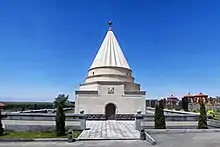
There is a Yazidi temple called Ziarat in the village of Aknalich in the region of Armavir. In September 2019, the largest Yazidi temple in the world called "Quba Mere Diwane", was opened in Aknalich, just a few meters from the Ziarat temple. The temple is privately funded by Mirza Sloian, a Yazidi businessman based in Moscow who is originally from the Armavir region.[85][86]
Turkey
A sizeable part of the autochthonous Yazidi population of Turkey fled the country for present-day Armenia and Georgia starting from the late 19th century.[71] There are additional communities in Russia and Germany due to recent migration.[35] The Yazidi community of Turkey declined precipitously during the 20th century. Most of them have immigrated to Europe, particularly Germany; those who remain reside primarily in villages in their former heartland of Tur Abdin.[25]
Western Europe
This mass emigration has resulted in the establishment of large Yazidi diaspora communities abroad. The most significant of these is in Germany, which now has a Yazidi community of more than 200,000[4][5] living primarily in Hannover, Bielefeld, Celle, Bremen, Bad Oeynhausen, Pforzheim and Oldenburg.[87] Most are from Turkey and, more recently, Iraq and live in the western states of North Rhine-Westphalia and Lower Saxony.[25] Since 2008, Sweden has seen sizeable growth in its Yazidi emigrant community, which had grown to around 4,000 by 2010, and a smaller community exists in the Netherlands.[25] Other Yazidi diaspora groups live in Belgium, Denmark, France, Switzerland, the United Kingdom, the United States, Canada and Australia; these have a total population of probably less than 5,000.[25]
North America
A community of Yazidis have settled as refugees in the United States of America and Canada. Many Yazidis now live in Lincoln, Nebraska[88][89][90][91] and Houston, Texas.[92][93][94] It is thought that Nebraska has the largest settlement (an estimated number of at least 10,000) of Yazidis in the United States, with a history of immigration to the state under refuge settlement programs starting in the late 1990s.[89] Many of the men of the community served as translators for the US military.[93][94]
Western perceptions
As the Yazidis hold religious beliefs that are mostly unfamiliar to outsiders, many non-Yazidi people have written about them and ascribed to their beliefs facts that have dubious historical validity. The Yazidis, perhaps because of their secrecy, also have a place in modern occultism.
In Western literature
_p454_GATE_OF_YEZEEDI_TEMPLE_SHEIKH_ADI.jpg.webp)
In William Seabrook's book Adventures in Arabia, the fourth section, starting with Chapter 14, is devoted to the "Yezidees" and is titled "Among the Yezidees". He describes them as "a mysterious sect scattered throughout the Orient, strongest in North Arabia, feared and hated both by Moslem and Christian, because they are worshippers of Satan." In the three chapters of the book, he completely describes the area, including the fact that this territory, including their holiest city of Sheik-Adi, was not part of "Irak".[95]
George Gurdjieff wrote about his encounters with the Yazidis several times in his book Meetings with Remarkable Men, mentioning that they are considered to be "devil worshippers" by other ethnicities in the region. Also, in Peter Ouspensky's book "In Search of the Miraculous", he describes some strange customs that Gurdjieff observed in Yazidi boys: "He told me, among other things, that when he was a child he had often observed how Yezidi boys were unable to step out of a circle traced round them on the ground" (p. 36)
Idries Shah, writing under the pen-name Arkon Daraul, in the 1961 book Secret Societies Yesterday and Today, describes discovering a Yazidi-influenced secret society in the London suburbs called the "Order of the Peacock Angel." Shah claimed Tawûsê Melek could be understood, from the Sufi viewpoint, as an allegory of the higher powers in humanity.[96]
In H.P. Lovecraft's story "The Horror at Red Hook", some of the murderous foreigners are identified as belonging to "the Yezidi clan of devil-worshippers".[97]
In Patrick O'Brian's Aubrey-Maturin series novel The Letter of Marque, set during the Napoleonic wars, there is a Yazidi character named Adi. His ethnicity is referred to as "Dasni".
A fictional Yazidi character of note is the super-powered police officer King Peacock of the Top 10 series (and related comics).[98] He is portrayed as a kind, peaceful character with a broad knowledge of religion and mythology. He is depicted as conservative, ethical, and highly principled in family life. An incredibly powerful martial artist, he is able to perceive and strike at his opponent's weakest spots, a power that he claims is derived from communicating with Malek Ta'us.
In US Army memoirs
In her memoir of her service with an intelligence unit of the US Army's 101st Airborne Division in Iraq during 2003 and 2004, Kayla Williams (2005) records being stationed in northern Iraq near the Syrian border in an area inhabited by "Yezidis". According to Williams, some Yazidis were Kurdish-speaking but did not consider themselves Kurds and expressed to her a fondness for America and Israel. She was able to learn only a little about the nature of their religion: she thought it very ancient, and concerned with angels. She describes a mountain-top Yazidi shrine as "a small rock building with objects dangling from the ceiling" and alcoves for the placement of offerings. She reported that local Muslims considered the Yazidis to be devil worshippers. (See #Persecution of Yazidis, below.)
In an October 2006 article in The New Republic, Lawrence F. Kaplan echoes Williams's sentiments about the enthusiasm of the Yazidis for the American occupation of Iraq, in part because the Americans protect them from oppression by militant Muslims and the nearby Kurds. Kaplan notes that the peace and calm of Sinjar is virtually unique in Iraq: "Parents and children line the streets when U.S. patrols pass by, while Yazidi clerics pray for the welfare of U.S. forces."[99]
Tony Lagouranis comments on a Yazidi prisoner in his book Fear Up Harsh: An Army Interrogator's Dark Journey through Iraq:
There's a lot of mystery surrounding the Yazidi, and a lot of contradictory information. But I was drawn to this aspect of their beliefs: Yazidi don't have a Satan. Malak Ta'us, an archangel, God's favorite, was not thrown out of heaven the way Satan was. Instead, he descended, saw the suffering and pain of the world, and cried. His tears, thousands of years' worth, fell on the fires of hell, extinguishing them. If there is evil in the world, it does not come from a fallen angel or from the fires of hell. The evil in this world is man-made. Nevertheless, humans can, like Malak Ta'us, live in this world but still be good.[100]
Persecution of Yazidis
Through their history, the Yazidi people have endured and survived 72 genocides as they upheld their religion in the face of severe Islamic persecution and attempts to force them to convert to Islam and "Arabize" them by the Ottoman Empire and later in the 20th century by Iraq.[101][41]
The belief of some followers of other monotheistic religions of the region that the Peacock Angel equates with their own unredeemed evil spirit Satan,[102]:29[71] has incited centuries of persecution of the Yazidis as "devil worshippers".[103][104]
Under the Ottoman Empire
A large Yazidi community existed in Syria, but it declined due to persecution by the Ottoman Empire.[105][106] Several punitive expeditions were organized against the Yazidis by the Ottoman governors (Wāli) of Diyarbakır, Mosul and Baghdad. The objective of these persecutions was the forced conversion of Yazidis to the Sunni Hanafi Islam of the Ottoman Empire.[107]
In post-invasion Iraq
On 7 April 2007, a crowd of up to 2,000 Yazidis stoned a 17-year-old Iraqi of the Yazidi faith, Du'a Khalil Aswad, to death.[108][109] Rumours that the stoning was connected to her alleged conversion to Islam prompted reprisals against Yazidis by Sunnis, including the 2007 Mosul massacre. In August 2007, some 500 Yazidis were killed in a coordinated series of bombings in Qahtaniya that became the deadliest suicide attack since the Iraq War began. In August 2009, at least 20 people were killed and 30 wounded in a double suicide bombing in northern Iraq, an Iraqi Interior Ministry official said. Two suicide bombers with explosive vests carried out the attack at a cafe in Sinjar, west of Mosul. In Sinjar, many townspeople are members of the Yazidi minority.[110]
By the Islamic State of Iraq and the Levant (ISIL)

In 2014, with the territorial gains of the Salafist militant group calling itself the Islamic State of Iraq and the Levant (ISIL) there was much upheaval in the Iraqi Yazidi population. ISIL captured Sinjar in August 2014 following the withdrawal of Peshmerga troops of Masoud Barzani, forcing up to 50,000 Yazidis to flee into the nearby mountainous region.[111] In early August the town of Sinjar was nearly deserted as Kurdish Peshmerga forces were no longer able to keep ISIL forces from advancing. ISIL had previously declared the Yazidis to be devil worshippers and had taken the two nearby small oil fields and the town of Zumar as part of a plan to try to seize Mosul's hydroelectric dam.[112] Up to 200,000 people (including an estimated 40,000 Yazidi[113]) fled the city before it was captured by ISIL forces, giving rise to fears of a humanitarian tragedy.[112] Alongside the local Yazidis fleeing Sinjar were Yazidis (and Shiites) who fled to the city a month earlier when ISIL captured the town of Tal Afar.[112][114]
Most of the population fleeing Sinjar retreated by trekking up nearby mountains with the ultimate goal of reaching Dohuk in Iraqi Kurdistan (normally a five-hour drive by car). Concerns for the elderly and those of fragile health were expressed by the refugees, who told reporters of their lack of water. Reports coming from Sinjar stated that sick or elderly Yazidi who could not make the trek were being executed by ISIL. Yazidi parliamentarian Haji Ghandour told reporters that "In our history, we have suffered 72 massacres. We are worried Sinjar could be a 73rd."[112]
UN groups say at least 40,000 members of the Yazidi sect, many of them women and children, took refuge in nine locations on Mount Sinjar, a craggy, 1,400 m (4,600 ft) high ridge identified in local legend as the final resting place of Noah's Ark, facing slaughter at the hands of jihadists surrounding them below if they fled, or death by dehydration if they stayed.[115] Between 20,000 and 30,000 Yazidis, most of them women and children, besieged by ISIL, escaped from the mountain after the People's Protection Units (YPG) and Kurdistan Workers' Party (PKK) intervened to stop ISIL and opened a humanitarian corridor for them,[116] helping them cross the Tigris into Rojava.[117] Some Yazidis were later escorted back to Iraqi Kurdistan by Peshmerga and YPG forces, Kurdish officials have said.[118][119]
Their plight received international media coverage,[120] which led United States President Barack Obama to authorise humanitarian airdrops of meals and water to thousands of Yazidi and Christian religious minorities trapped on Sinjar mountain. President Obama also authorised "targeted airstrikes" against Islamic militants in support of the beleaguered religious minority, and to protect American military personnel in northwest Iraq.[121][122] American humanitarian assistance began on 7 August 2014,[123] with the UK Royal Air Force subsequently contributing to the relief effort.[124] At an emergency meeting in London, Australian prime minister Tony Abbott also pledged humanitarian support,[125] while European nations resolved to join the US in helping to arm Peshmerga fighters aiding the Yazidis with more advanced weaponry.[126]
Later PKK and YPG fighters with Peshmergas and support of the US airstrikes helped the rest of the trapped Yazidis to escape from the mountain.[127][128] One relief worker in the evacuation operation described the conditions on Mount Sinjar as "a genocide", having witnessed hundreds of corpses.[117] Yazidi girls in Iraq allegedly raped by ISIL fighters have committed suicide by jumping to their death from Mount Sinjar, as described in a witness statement.[129] In Sinjar, ISIL destroyed a Shiite shrine and demanded that the remaining population convert to their version of Islam, pay jizya (a religious tax) or be executed.
Captured women are treated as sex slaves or spoils of war, some are driven to suicide. Women and girls who convert to Islam are sold as brides, those who refuse to convert are tortured, raped and eventually murdered. Babies born in the prison where the women are held are taken from their mothers to an unknown fate.[130][131] Nadia Murad, a Yazidi human rights activist and 2018 Nobel Peace Prize winner, was kidnapped and used as a sex slave by the ISIL in 2014.[132]
Haleh Esfandiari from the Woodrow Wilson International Center for Scholars has highlighted the abuse of local women by ISIL militants after they have captured an area. "They usually take the older women to a makeshift slave market and try to sell them. The younger girls ... are raped or married off to fighters", she said, adding, "It's based on temporary marriages, and once these fighters have had sex with these young girls, they just pass them on to other fighters."[133] Speaking of Yazidi women captured by ISIL, Nazand Begikhani said "[t]hese women have been treated like cattle... They have been subjected to physical and sexual violence, including systematic rape and sex slavery. They've been exposed in markets in Mosul and in Raqqa, Syria, carrying price tags."[134] Dr. Widad Akrawi said that ISIL uses slavery and rape as weapons of war.[135]
In September 2014, Defend International launched a worldwide campaign entitled "Save The Yazidis: The World Has To Act Now" to raise awareness about the tragedy of the Yazidis in Sinjar and to co-ordinate activities related to intensifying efforts aimed at rescuing Yazidi and Christian women and girls captured by ISIL.[136] In October 2014, the United Nations reported that more than 5,000 Yazidis had been murdered and 5,000 to 7,000 (mostly women and children) had been abducted by ISIL.[137] In the same month, President of Defend International dedicated her 2014 International Pfeffer Peace Award to the Yazidis.[138] She asked the international community to make sure that the victims are not forgotten; they should be rescued, protected, fully assisted and compensated fairly.[136]
ISIS has, in their digital magazine Dabiq, explicitly claimed religious justification for enslaving Yazidi women.[139] In December 2014, Amnesty International published a report.[140][141] Despite the oppression Yazidis' women have sustained, they have appeared on the news as examples of retaliation. They have received training and taken positions at the frontlines of the fighting, making up about a third of the Kurd–Yazidi coalition forces, and have distinguished themselves as soldiers.[142][143]
See also
| Wikimedia Commons has media related to Yezidis. |
References
- Lamb, Christina (22 September 2020). Our Bodies, Their Battlefields: War Through the Lives of Women. Simon and Schuster. p. 24. ISBN 978-1-5011-9917-2.
- "Aziz Tamoyan blames unknown forces for crippling history and culture of Yazidis". armenpress.am. Retrieved 10 January 2021.
- "Surviving Islamic State: The Plight Of The Yazidi Community". Nikita Malik. Forbes. Retrieved 13 January 2019.
- Alkaidy, Gohdar (28 January 2019). "Mir Tahsin Said Beg: Oberhaupt der Jesiden stirbt im deutschen Exil". Retrieved 19 May 2019.
- Meyer, Natalie Lydia. "Geschichten vom Leid der Verfolgung". Westfalen-Blatt (in German). Retrieved 19 May 2019.
- Приложение 2. Национальный состав населения по субъектам Российской Федерации. Statistics of Russia (in Russian). Statistics of Russia. Retrieved 22 August 2018.
- "Exhibition in Brussels on the Yazidi community in Iraq". 10 January 2018. Retrieved 13 January 2019.
- "2011 Armenian census" (PDF). Retrieved 18 August 2014.
- "Ethnic Composition of Georgia" (PDF). CSEM. Retrieved 18 May 2019.
- Knapp, Fred. "Iraqis a fast-growing group in Nebraska | netnebraska.org". netnebraska.org.
- "La communauté Yézidie en France". Retrieved 13 January 2019.
- "Non, les Yézidis ne sont pas voués à disparaître". 1 August 2018. Retrieved 13 January 2019.
- Armstrong, Kerrie (22 August 2017). "The Yazidi people: who are they and why are they on the run?". Explainer. SBS. Retrieved 25 February 2019.
- Andrea Glioti (18 October 2013). "Yazidis Benefit From Kurdish Gains in Northeast Syria". al-monitor. Archived from the original on 19 February 2014. Retrieved 1 April 2014.
- "Många yazidier fortfarande försvunna" (in Swedish). SVT. 9 January 2018. Retrieved 13 January 2019.
- "Turkey". U.S. Department of State. Retrieved 22 January 2019.
- International Religious Freedom (2010): Annual Report to Congress. DIANE Publishing. ISBN 9781437944396.
- "Statement on ABC Four Corners reporting". www.homeaffairs.gov.au. Retrieved 21 August 2019.
- "For a Yazidi refugee in Canada, the trauma of ISIS triggers rare, terrifying seizures". 1 December 2018. Retrieved 13 January 2019.
- Arakelova, Victoria. "Ethno-Religious Communities Identity markers". Yerevan State University. Cite journal requires
|journal=(help) - "Population (urban, rural) by Ethnicity, Sex and Religious Belief" (PDF). Statistics of Armenia. Statistics of Armenia. Retrieved 22 May 2019.
- Nelida Fuccaro (1999). The Other Kurds: Yazidis in Colonial Iraq. London & New York: I. B. Tauris. p. 9. ISBN 1860641709.
- "Yazidis who suffered under Isis face forced conversion to Islam amid fresh persecution in Afrin". The Independent. 18 April 2018. Retrieved 27 September 2019.
- Dalalyan, Tork. "Construction of Kurdish and Yezidi Identities among the Kurmanji-speaking Population of the Republic of Armenia, in". Changing Identities: Armenia, Azerbaijan, Georgia (Collection of Selected Works, Edited by V. Voronkov, S. Khutsishvili, J. Horan), Heinrich Böll Stiftung South Caucasus: 189.
- Allison, Christine (20 February 2004). "Yazidis i: General". Encyclopædia Iranica. Retrieved 20 August 2010.
- "Population Census 2011 – Table 5.2-1 Population (urban, rural) by Ethnicity, Sex and Mother Tongue" (PDF). Statistics of Armenia. Retrieved 23 May 2019.
- "Yazidi". Oxford Dictionaries | English. Retrieved 13 March 2019.
- Philip G. Kreyenbroek, Khalil Jindy Rashow, Khalīl Jindī (2005). God and Sheikh Adi are Perfect: Sacred Poems and Religious Narratives from the Yezidi Tradition. p. 118. ISBN 3-447-05300-3.CS1 maint: multiple names: authors list (link)
- "خانمانی ئێزیدی جــلـی رهش فڕێدهدهن" (in Kurdish). Retrieved 13 February 2020.
- Kane, Sean (2011). "Iraq's disputed territories" (PDF). PeaceWorks. United States Institute of Peace. Retrieved 15 October 2018.
- "On Vulnerable Ground – Violence against Minority Communities in Nineveh Province's Disputed Territories" (PDF). hrw.org. Human Rights Watch. November 2009. Retrieved 15 October 2018.
- Ali, Majid Hassan (15 February 2019). "The identity controversy of religious minorities in Iraq: the crystallization of the Yazidi identity after 2003". British Journal of Middle Eastern Studies: 15. doi:10.1080/13530194.2019.1577129.
- "UNHCR's Eligibility Guidelines for Assessing the International Protection Needs of Iraqi Asylum-Seekers" (PDF). pp. 11, 76.
- Schmermund, Elizabeth (15 December 2017). ISIS and the Yazidi Genocide in Iraq. The Rosen Publishing Group, Inc. ISBN 9781508177319.
- Garnik S. Asatrian, Victoria Arakelova (2014). The Religion of the Peacock Angel: The Yezidis and Their Spirit World. ISBN 978-1317544289. Retrieved 17 May 2019.
- Eckardt, Frank; Eade, John (1 January 2011). The Ethnically Diverse City. BWV Verlag. p. 73. ISBN 978-3-8305-1641-5.
- "Statement by the Commission of Inquiry on Syria on the second anniversary of 3 August 2014 attack by ISIS of the Yazidis". www.ohchr.org. OHCHR. Retrieved 17 May 2019.
- Mission scientifique du Maroc (1907). Revue du monde musulman (in French). Robarts - University of Toronto. Paris E. Leroux. p. 583.
- "Encyclopaedia Iranica: Yazidis". Iranicaonline.org. Retrieved 18 August 2014.
- Ceyhan Suvari, Çakır. "Yezidis: An Ethno-Religious Group in Turkey" (PDF). p. 32.
- "What you did not know about Iraq's Yazidi minority". Al Arabiya News. 11 August 2014.
- P.G. Kreyenbroek, "Yazīdī" in Encyclopedia of Islam, s.v.
- Bocheńska, Joanna (26 October 2018). Rediscovering Kurdistan's Cultures and Identities: The Call of the Cricket. Springer. ISBN 978-3-319-93088-6.
- Kreyenbroek 1995, pp. 54; 59.
- Foltz, Richard. Two Kurdish Sects: The Yezidis and the Yaresan. p. 219. Archived from the original on 4 February 2015. Retrieved 27 February 2019.
- Foltz, Richard (22 October 2013). "Mithra and Mithraism". Religions of Iran: From Prehistory to the Present. p. 30. ISBN 978-1-78074-307-3.
- Joseph 1919, pp. 119–21
- Açikyildiz, Birgül (23 December 2014). The Yezidis: The History of a Community, Culture and Religion. I.B.Tauris. ISBN 9780857720610.
- Gidda, Mirren. "Everything You Need to Know About the Yazidis". TIME.com. Retrieved 7 February 2016.
- Eagleton, William (1988). An Introduction to Kurdish Rugs and Other Weavings. Scorpion. p. 12. ISBN 978-0-905906-50-8.
- Ceyhan Suvari, Çakır. "Yezidis: An Ethno-Religious Group in Turkey" (PDF).
- Serinci, Deniz (28 May 2014). "The Yezidis of Armenia Face Identity Crisis over Kurdish Ethnicity". Rudaw Media Network.
- Green, Emma (13 August 2014). "The Yazidis, a People Who Fled". The Atlantic.
- Non-State Violent Actors and Social Movement Organizations: Influence, Adaptation, and Change. Emerald Group Publishing. 26 April 2017. ISBN 9781787147287.
- Guest (12 November 2012). Survival Among The Kurds. Routledge. ISBN 9781136157363.
- Levon Abrahamian (2006). Armenian identity in a changing world. p. 116.
- Allison, Christine (2001). The Yezidi Oral Tradition in Iraqi Kurdistan. Psychology Press. pp. 38–40. ISBN 9780700713974.
- Spät, Eszter (2018). "Yezidi Identity Politics and Political Ambitions in the Wake of the ISIS Attack". Journal of Balkan and Near Eastern Studies. 20 (5): 425. doi:10.1080/19448953.2018.1406689. S2CID 148897618.
- Asatrian, Garnik S.; Arakelova, Victoria (3 September 2014). The Religion of the Peacock Angel: The Yezidis and Their Spirit World. Routledge. ISBN 978-1-317-54429-6.
- Asatrian, Garnik S.; Arakelova, Victoria (3 September 2014). The Religion of the Peacock Angel: The Yezidis and Their Spirit World. Routledge. p. viii. ISBN 9781317544296.
- Rodziewicz, Artur (2018). "Milete min Êzîd. The Uniqueness of the Yezidi Concept of the Nation". ResearchGate. p. 70.
- Rodziewicz, Artur (2018). "Milete min Êzîd. The Uniqueness of the Yezidi Concept of the Nation". ejournals.eu. p. 70.
- Asatrian, Garnik S.; Arakelova, Victoria (3 September 2014). The Religion of the Peacock Angel: The Yezidis and Their Spirit World. Routledge. p. 29. ISBN 978-1-317-54429-6.
- "Armenian International Magazine" (PDF). May 1992. p. 31.
- Brennan, Shane; Herzog, Marc (30 July 2014). "Turkey and the Politics of National Identity: Social, Economic and Cultural Transformation". New York: I.B.Tauris, 2014. ISBN 978-1-78076-539-6.
- Chantre, Ernest (1895). "Notes ethnologiques sur les Yésidi". Publications de la Société Linnéenne de Lyon (in French). 14 (1): 74. doi:10.3406/linly.1895.12079.
- King, Diane E. (31 December 2013). Kurdistan on the Global Stage: Kinship, Land, and Community in Iraq. Rutgers University Press. ISBN 9780813563541.
- Travis, Hannibal (2010). Genocide in the Middle East: The Ottoman Empire, Iraq, and Sudan. Carolina Academic Press. ISBN 9781594604362.
- Ghareeb, Edmund A.; Dougherty, Beth (18 March 2004). Historical Dictionary of Iraq. Scarecrow Press. p. 248. ISBN 9780810865686.
- Ceyhan Suvari, Çakır. "Yezidis: An Ethno-Religious Group in Turkey" (PDF). p. 30.
- Açikyildiz, Birgül (2014). The Yezidis: The History of a Community, Culture and Religion. London: I.B. Tauris & Company. ISBN 978-1-784-53216-1. OCLC 888467694.
- Adam Valen Levinson The Abu Dhabi Bar Mitzvah: Fear and Love in the Modern Middle East W. W. Norton & Company 2017 ISBN 978-0-393-60837-3
- Asher-Schapiro, Avi (11 August 2014). "Who Are the Yazidis, the Ancient, Persecuted Religious Minority Struggling to Survive in Iraq?". National Geographic.
- Thomas, Sean (19 August 2007). "The Devil worshippers of Iraq". The Daily Telegraph.
- Gidda, Mirren. "Everything You Need to Know About the Yazidis". TIME.com. Retrieved 7 February 2016.
- "Consequently, despite corresponding to isolated and homogenous populations, contemporary Syriacs and Yazidis from Northern Iraq may in fact have a stronger continuity with the original genetic stock of the Mesopotamian people, which possibly provided the basis for the ethnogenesis of various subsequent Near Eastern populations.
the Northern Iraqi Assyrian and Yazidi populations from the current study were found to position in the middle of a genetic continuum between the Near East and Southeastern Europe." http://journals.plos.org/plosone/article?id=10.1371/journal.pone.0187408 - "Question of the Frontier Between Turkey and Iraq" (PDF). Geneva: League of Nations. 20 August 1925. p. 49.
- Dulz, Irene (2001). Die Yeziden im Irak: zwischen "Modelldorf" und Flucht (in German). LIT Verlag Münster. p. 54. ISBN 9783825857042.
- Federal Research Division. Syria. "Chapter 5: Religious Life". Library of Congress Country Studies. Retrieved 20 August 2010.
- Commins, David Dean (2004). Historical Dictionary of Syria. Scarecrow Press. p. 282. ISBN 0-8108-4934-8. Retrieved 20 August 2010.
- "Yazidi temple, third in the world, opened in Tbilisi". DFWatch. 19 June 2015. Retrieved 19 June 2015.
- "2011 Armenian census" (PDF). National Statistical Service. 2011. Retrieved 6 July 2017.
- "De Jure Population (Urban, Rural) by Age and Ethnicity" (PDF). National Statistical Service. 2001. Retrieved 9 December 2015.
- Aren Torikian (27 August 2014). "Confronting the Yazidi Genocide". The Armenian Weekly.
- "World's Largest Yezidi Temple Opens in Armenia". Massis Post. 30 September 2019.
- Sherwood, Harriet (25 July 2016). "World's largest Yazidi temple under construction in Armenia". the Guardian. Retrieved 21 May 2018.
- Gezer, Özlem (23 October 2014). "From Germany to Iraq: One Yazidi Family's War on Islamic State". Der Spiegel. Retrieved 24 June 2015.
- "Terrorized by ISIS, Yazidi refugees find welcoming community in Nebraska". PBS NewsHour. 15 January 2018.
- Knapp, Fred (15 August 2014). "Yazidis and other Iraqis in Lincoln offer different perspectives on crisis". NET Nebraska.
- Roberts, Dave; McCartney, Rob; Petersen, Brandi (10 November 2014). "Nebraskan Yazidis want to stop carnage by Islamic State in Iraq". KETV. Retrieved 24 September 2016.
- Williams, Jack (14 December 2017). "Yazidis from Iraq Find Welcome Refuge in Nebraska" (Includes audio). NET Nebraska.
- Flakus, Greg (14 August 2015). "America's Heartland Helps Iraq's Yazidis". Voice of America. Retrieved 23 September 2016.
- Flakus, Greg (30 September 2016). "Yazidi-American Activist Seeks Help for Refugees". Voice of America. Retrieved 24 September 2016.
- Flakus, Greg (1 October 2015). "Yazidi Americans Seek Help for their People". Voice of America. Retrieved 23 September 2016.
- Seabrook, W.B., Adventures in Arabia, Harcourt, Brace, and Company (1927).
- Shah, Idries (1964). The Sufis. Anchor Doubleday. pp. 437–38. ISBN 0-385-07966-4.
- Lovecraft, H.P., The Complete Fiction, Barnes & Noble, 2008; ISBN 978-1-4351-2296-3
- Moore, Alan and Ha, Gene (1999–2000) Top Ten issues 1–12,
- Kaplan, Lawrence F. (31 October 2007). "Sinjar Diarist: Devil's Advocates". The New Republic. 235 (4790): 34.
- Lagouranis, Tony (2007). Fear Up Harsh: An Army Interrogator's Dark Journey through Iraq. New American Library. p. 128. ISBN 978-0-451-22112-4.
- Asher-Shapiro, Avi (11 August 2014). "Who Are the Yazidis, the Ancient, Persecuted Religious Minority Struggling to Survive in Iraq?". National Geographic. Retrieved 18 November 2020.
- van Bruinessen, Martin (1992). "Chapter 2: Kurdish society, ethnicity, nationalism and refugee problems". In Kreyenbroek, Philip G.; Sperl, Stefan (eds.). The Kurds: A Contemporary Overview. London: Routledge. pp. 26–52. ISBN 978-0-415-07265-6. OCLC 919303390.
- Li, Shirley (8 August 2014). "A Very Brief History of the Yazidi and What They're Up Against in Iraq". The Atlantic.
- Jalabi, Raya (11 August 2014). "Who are the Yazidis and why is Isis hunting them?". The Guardian.
- Commins, David Dean (2004). Historical Dictionary of Syria. Scarecrow Press. p. 282. ISBN 0-8108-4934-8.
- Ghareeb, Edmund A. (2004). Historical Dictionary of Iraq. Scarecrow Press. p. 248. ISBN 0-8108-4330-7.
- Hastings, James (2003). Encyclopedia of Religion and Ethics Part 18. Kessinger. p. 769. ISBN 0-7661-3695-7.
- "Video Captures Stoning of Kurdish Teenage Girl". 25 April 2007.
- Lattimer, Mark (13 December 2007). "Freedom lost". The Guardian.
- "At least 20 killed in Iraq blast". CNN.com International. 13 August 2009. Retrieved 13 August 2009.
- "Isil militants execute dozens from Yazidi minority". Gulf News. 5 August 2014. Retrieved 13 August 2014.
- Morris, Loveday (3 August 2014). "Families flee as Islamic State extremists seize another Iraqi town, pushing back the Kurds". The Washington Post.
- Bram Janssen & Sameer N. Yacoub (4 August 2014). "Iraq Air Force to Back Kurds Fighting Islamists". Associated Press. Retrieved 3 July 2015.
- "Who Are the Yazidi, and Why Is ISIS Targeting Them?". NBC News. 8 August 2014.
- Chulov, Martin (6 August 2014). "40,000 Iraqis stranded on mountain as Isis jihadists threaten death". The Guardian.
- "Kurds rescue Yazidis from Iraqi mountain". Al Jazeera. 10 August 2014. Retrieved 12 August 2014.
- "Thousands of Yazidis 'still trapped' on Iraq mountain". BBC News. 12 August 2014.
- Siddique, Haroon (10 August 2014). "20,000 Iraqis besieged by ISIL escape from mountain after US air strikes". The Guardian.
- "Syrian Kurdish fighters rescuing stranded Yazidis". Associated Press. 24 March 2015. Retrieved 29 August 2019.
- "Iraqi Yazidis: 'If we move they will kill us'". Al Jazeera. 5 August 2014. Retrieved 8 August 2014.
- Obama, Barack (7 August 2014). "Statement by the President". Whitehouse.gov.
- Cooper, Helene; Landler, Mark; Rubin, Alissa J. (7 August 2014). "Obama Allows Limited Airstrikes on ISIS". The New York Times.
- "Obama authorises Iraq air strikes on Islamist fighters". BBC World News. 8 August 2014. Retrieved 3 July 2015.
- "Britain's RAF makes second aid drop to Mount Sinjar Iraqis trapped by Isis – video". The Guardian. 12 August 2014. Retrieved 12 August 2014.
- "Iraq crisis: Tony Abbott says Australia's role in Iraq only humanitarian 'at this stage'; UN calls for 'urgent' international action". ABC News. 13 August 2014. Retrieved 3 July 2015.
- "Europe pledges aid, equipment to Iraq". ABC News. 12 August 2014. Retrieved 12 August 2014.
- "Kurds rescue Yazidis from Iraqi mountain". Al Jazeera. 10 August 2014. Retrieved 30 August 2019.
- "After pivotal role saving Yazidis from ISIS, PKK leaves Sinjar – Middle East – Jerusalem Post". Jerusalem Post. 4 April 2018. Retrieved 30 August 2019.
- Ahmed, Havidar (14 August 2014). "The Yezidi Exodus, Girls Raped by ISIS Jump to their Death on Mount Shingal". Rudaw Media Network. Retrieved 26 August 2014.
- "Islamic State crisis: Yazidi anger at Iraq's forgotten people". BBC News. Retrieved 23 December 2014.
- "IS in Iraq: Yazidi women raped, murdered and sold as brides – Christian News on Christian Today". Retrieved 23 December 2014.
- Alter, Charlotte (20 December 2015). "A Yezidi Woman Who Escaped ISIS Slavery Tells Her Story". Time Magazine. Retrieved 6 July 2017.
- Brekke, Kira (8 September 2014). "ISIS Is Attacking Women, And Nobody Is Talking About It". The Huffington Post. Retrieved 11 September 2014.
- Ivan Watson, "'Treated like cattle': Yazidi women sold, raped, enslaved by ISIS", CNN, 30 October 2014.
- "Dr Widad Akrawi Interviewed at RojNews: How should the international community classify the systematic massacre of the Yezidi civilians in Sinjar by IS jihadists that included taking Yezidi girls as sex slaves". Archived from the original on 28 October 2015. Retrieved 26 September 2015.
- "Save The Yazidis: The World Has To Act Now". Retrieved 12 September 2014.
- Richard Spencer, "Isil carried out massacres and mass sexual enslavement of Yazidis, UN confirms", The Daily Telegraph, 14 October 2014.
- "Dr Widad Akrawi awarded International Pfeffer Peace Prize". Retrieved 20 October 2014.
- Reuters, "Islamic State Seeks to Justify Enslaving Yazidi Women and Girls in Iraq", Newsweek, 13 October 2014.
- "Islamic State: Yazidi women tell of sex-slavery trauma". BBC News. Retrieved 23 December 2014.
- "Sex slavery 'pushes ISIL victims to suicide'", Al Jazeera, 23 December 2014.
- Dirik, Dilar (21 August 2015). "From Genocide to Resistance: Yazidi Women Fight Back". Retrieved 21 November 2015.
- Barbarani, Sofia (2 September 2014). "'Islamic State tore our families apart. Now we're fighting back'. Meet the Kurdish women's resistance army". Newsgroup: telegraph.co.uk. Retrieved 21 November 2015.
Further reading
- Açıkyıldız, Birgül (2014). The Yezidis: The History of a Community, Culture and Religion. London: I.B. Tauris & Company. ISBN 978-1-784-53216-1. OCLC 888467694.
- Cumont, Franz (1911). The Oriental Religions in Roman Paganism. Chicago, IL: Open Court Publishing. pp. 152–153. ISBN 978-0-486-20321-8. OCLC 670375427.
- Drower, E.S. (1941). Peacock Angel; Being Some Account of Votaries of a Secret Cult and Their Sanctuaries. London: John Murray. OCLC 4821609.
- Husseini, Rana (2012). "Chapter 15. The Historical and Religious Seeds of 'Honor'". In Clark, Kelly James (ed.). Abraham's Children: Liberty and Tolerance in an Age of Religious Conflict. New Haven: Yale University Press. ISBN 978-0-300-18333-7. OCLC 809235956.
- Joseph, Isya (January 1909). "Yezidi Texts". The American Journal of Semitic Languages and Literatures. 25 (2): 111–156. doi:10.1086/369616. JSTOR 527914.
- Kreyenbroek, Philip G. (1995). "Yezidism -- Its Background, Observances, and Textual Tradition". Texts and Studies in Religion (in Kurdish and English). Lewiston, Queenston and Lampeter, NY: Edwin Mellen Press. 62. OCLC 31377794. ISBN 978-0-773-49004-8
- Kreyenbroek, Philip G.; Kartal, Z.; Omarkhali, Kh.; Rashow, Kh. Jindy (2009). Yezidism in Europe: Different Generations Speak About Their Religion. Wiesbaden: Harrassowitz Verlag. ISBN 978-3-447-06060-8. OCLC 554952854.
- Omarkhali, Kh. "Yezidism: Society, Symbol, Observance". Istanbul, 2007. In Kurdish.
- Reshid, T. Yezidism: historical roots, International Journal of Yezidi Studies, January 2005.
- Rodziewicz, A., Yezidi Eros. Love as The Cosmogonic Factor and Distinctive Feature of The Yezidi Theology in The Light of Some Ancient Cosmogonies, Fritillaria Kurdica, 2014/3,41, pp. 42–105.
- Rodziewicz, A., Tawus Protogonos: Parallels between the Yezidi Theology and Some Ancient Greek Cosmogonies, Iran and the Caucasus, 2014/18,1, pp. 27–45.
- Williams, Kayla, and Michael E. Staub. 2005. Love My Rifle More Than You. W.W. Norton, New York. ISBN 0-393-06098-5
- Victoria Arakelova Yezdistan versus Kurdistan: Another Legend on the Origin of the Yezidis // Iran and the Caucasus 21 (2017)
External links
| Wikisource has original text related to this article: |
- Les Ezidis de France
- Yazda – A Global Yazidi Organization
- The Beginning of the Universe, photos and a description of Yezidi life in Lalish, Iraq, by Michael J. Totten (22 February 2006).
- Rubin, Alissa J. (14 October 2007). "Persecuted Sect in Iraq Avoids Its Shrine". The New York Times. Retrieved 4 August 2009.
